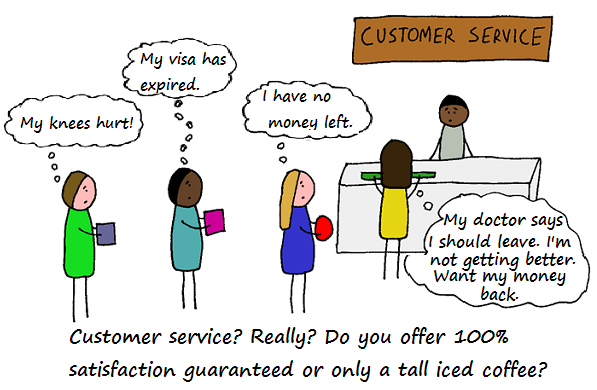 Ever since hospitals have started realizing the importance of marketing in their scheme of things, the rules of the game for hospitals have changed.
Ever since hospitals have started realizing the importance of marketing in their scheme of things, the rules of the game for hospitals have changed.
Creating a favorable impression for the hospital is a very complex job and would test the mettle of any service industry veteran. Customer service has become a keystone to creating a favorable impression and, one expects, greater word of mouth advertising and hence, a steady stream of new patients.
The service industry presents a suitable framework within which a hospital may understand its customer service opportunities or touch points. Services that hospitals provide can be viewed as one of three types: functional, mechanical or technical, and emotional or humanistic. These classifications are not watertight and there are times when these distinctions get blurred.
Functional indicators of customer service
Functional markers are by far the most important indicators of the service quality, especially when the service requires special skills. The margin for error in medical industry is very narrow, and often there’s no second chance. Functional markers act as the lodestone which primarily attracts the customer to you, the service provider. You do a great disservice to yourself if you slip up in your core service promise.
Functional markers indicate the reliability and competence of the service. Was the surgeon as skillful as he was promoted to be? Was the right diet (as prescribed by the dietician) served during the stay?
Mechanical indicators of customer service
Mechanical markers are reflected in the sights, smells, tastes and textures of the service. Seeing is believing. It’s not that medical diagnosis is not possible in a dilapidated OPD room, but it generally doesn’t do much for a patient’s confidence in your services and is most likely to put the patient in a negative frame of mind. If the television set in the patient’s private ward is elevated and angled for convenient viewing in bed, the patient’s confidence in the thoughtfulness of the service provider is enhanced.
 Bundled as a patient in a hospital, we often are thankful for the small mercies – like the bathroom door showing a cleaning job sheet with signed supervision by the superior on a regularly scheduled basis. A neutral odor on the ward would be a pleasant indicator of things done in the right proportion without going overboard with the disinfection and sanitization act. Unbroken and unstained ceiling or floor tiles, conveniently placed hand sterilization canisters, equipment covered and neatly stored, well-organized and managed nurses’ stations are all assurance to the patient that the care will be as unbroken, well placed, organized and managed.
Bundled as a patient in a hospital, we often are thankful for the small mercies – like the bathroom door showing a cleaning job sheet with signed supervision by the superior on a regularly scheduled basis. A neutral odor on the ward would be a pleasant indicator of things done in the right proportion without going overboard with the disinfection and sanitization act. Unbroken and unstained ceiling or floor tiles, conveniently placed hand sterilization canisters, equipment covered and neatly stored, well-organized and managed nurses’ stations are all assurance to the patient that the care will be as unbroken, well placed, organized and managed.
For the surgeon, the patient who is contemplating undergoing an elective surgery is in no position to directly judge the surgeon’s competence without going under the knife himself. However, during the consultation between the surgeon and the patient, if the patient’s eye catches a picture of the surgeon accepting an award from the Prime Minister, the patient’s estimate of the surgeon is bound to go up several notches.
Humanistic indicators of customer service
Emotional or humanistic markers are embedded in the verbal and non-verbal communication of the service providers.
Uncommon empathy, resourcefulness and efficiency are unlikely to go unnoticed especially in the hospital environment. With fate and illness already having dealt a blow, patients grasp at proverbial straws of reassurance that the choices made were right and that everything will turn out fine. This is where friendly hospital staff have a chance of cementing a profound emotional connection as the “friend in need.”
For many hospitals, “customer service” doesn’t go beyond the front office. Yet, each member of the hospital unit, from the security staff to the doctors and directors, is a walking advertisement of a synergistic service promise. If the hospital meticulously recruits its entire staff with the right “aptitude & attitude match” for the healthcare provider industry, it will be favorably positioned to present an excellent emotional perception of service quality to its patients.
The best hospitals understand that all these three aspects of customer service must be in place, integrated and woven seamlessly into the daily fabric of the hospital’s life. This is what makes a powerful service story.
By Sandip Chaudhuri
Manager – Business Development| Corporate Communications
Genesis Hospital, Kolkata

 >
>
Pingback: The other dimension of customer service · MTQUA | Medical tourism quality, safety and patient care best practice.
Pingback: Hospital customer service doesn’t guarantee satisfaction · MTQUA | Medical tourism quality, safety and patient care best practice.
Pingback: Implementing a customer service strategy in a hospital · MTQUA | Medical tourism quality, safety and patient care best practice.